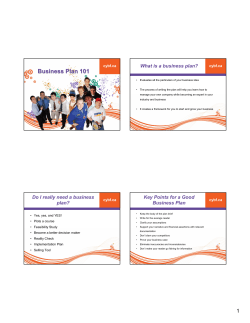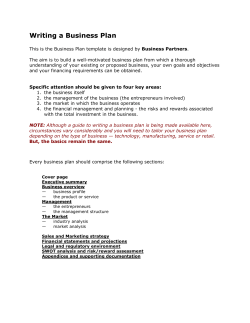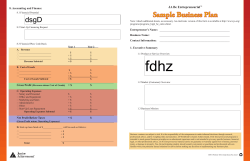
Writing a Successful Business Plan Professor John Newman Babson College
Writing a Successful Business Plan Professor John Newman Babson College What Is a Business Plan? IDENTIFICATION AND ARTICULATION OF: Opportunity, Market, Customers Management Capable of Seizing It Minimal Required Resources Entry Strategy & Tangible Vision for Growth Financial Requirements, Cash Flow & Deal Critical Risks & Assumptions Harvest Options Source: Ed Marram, Babson College Goals of a Business Plan Evaluate feasibility of the idea Development of strategy Entry, early growth, acquisition, LBO, harvest, etc. Assist in obtaining resources/approval Establish credibility Sample Business Plan Outline Table of Contents Executive Summary Industry, Products or Services Market Research Marketing Plan Management Team Development Plan Operations Plan Schedule Critical Risks Financial Plan Proposed Offer Appendices Financial Projections Start-up Costs Breakeven Chart Elements of a Successful Plan Clear description of the idea Overview of industry to suggest need/opportunity Evidence that demand exists (or can be created or stolen) Clear description of resource requirements: marketing, operations, financing Background of management team Schedule Discussion of risks, rewards, and offer Sample Business Plan Outline Table of Contents Executive Summary Industry, Products or Services Market Research Marketing Plan Management Team Development Plan Operations Plan Schedule Critical Risks Financial Plan Proposed Offer Appendices Financial Projections Start-up Costs Breakeven Chart Business Plans: Investor Decision Process Market Attractiveness •Market Need •Size of Market •Market Growth •Access to Market Product Differentiation •Uniqueness •Product Life •Profit Margin •Value Added Managerial Capabilities •Management Skills •Marketing Skills •Financial Skills •References Resistance to Threats •Barriers to Entry •Obsolescence Risk •Downside Risk •Economic Cycle Risk Expected Return + Decision to Invest Perceived Risk -- Entrepreneurship: Strategies and Resources Key Points to Remember General Guidelines Clear, concise, professional style Well-researched and documented Consistent and cohesive Business plans are: Very specific Not promotional tools, selling is subtle Industry Section Industry Overview Size, growth rate, segmentation, trends, regulatory environment Opportunity Product Overview Competitive Advantage Fit with Corporate Objectives Entry and Exit Strategies Market Research Identify Market Area and Size Description of Primary Customers Who, how many, what they want, what they do Research and Support for Demand Competitor Analysis Positioning map, strengths, weaknesses, likely competitive response Marketing Plan Mission Statement Product Characteristics Features Pricing Sales/Channel Strategies Promotional Strategy Support Policies Sales Projections On-going Evaluation The key is to build on your market research ... Management Team Managerial Positions Required Responsibilities Biography Ownership Structure Key Advisors Professional Support Design and Development Plans Development Status and Tasks Costs Difficulties and Risks Proprietary Issues (partial, not complete) Product Improvement and New Products Operations Plan Facility and Location Requirements Equipment Requirements Non-managerial staffing Sources of Supply Production Process and Controls Distribution logistics Regulatory and other compliance issues Schedule Gantt Chart showing: Tasks Time frame Cost Person responsible Critical Risks: Identification, Evaluation, Mitigation Identify major risks (7-10 is typical) Look beyond the simplistic (sales fall short) Evaluate impact should risk occur Describe how the risk will be mitigated and how you will respond should it happen Ask others what holes they see in your plan. What can go wrong ? Entrepreneurs frequently get too close to their ideas. You need unbiased views here ... Critical Risks: An Example Key Member of the Management Team is Injured Evaluation: Management is in excellent health and will refrain from dangerous activities. Thus, it is considered unlikely that a member of the management team will be incapacitated. Contingency: The company will ensure that key members of the management team undergo physical examinations annually. In addition, the company will provide key-man life insurance sufficient to protect outside investors’ capital in the event of an emergency. Financial Plan Start-up Requirements (Investment required) Review of Financial Characteristics Return Measures (IRR, ROI, EVA) Be careful not to promise Breakeven Concerns Sales, margins, profits Sales level, time to cash stability Extraordinary financial events Avoid describing your assumptions. The goal here is to convey the characteristics of your business briefly. Executive Summary Clear description of idea Arguments for success Overview of Industry, Market, Need, Demand Benefits to Customer / Company Fit with Company Objectives Team Financial Characteristics Sales, profits, investment, risk and returns Appendices: (Could Include Such Items As) Lists, specs, pictures of products, systems, software List of customers, suppliers, references Appropriate location factors, facilities or technical analysis Independent reports by technical expert, consultants Detailed resumes of founders, key managers Any critical regulatory, environmental or other compliance, licenses or approvals Sales or other financials assumptions (in brief) Source: Ed Marram, Babson College Key Considerations Have a “story to tell” Be confident but objective and dispassionate Understand the financial characteristics of your business Avoid promises and self-aggrandizement Tease to stimulate interest, never bore Miscellaneous Concerns Length is typically 20-40 pages, excl. exhibits Required appendices Financial statements (3-5 years) Statement of Start-up Costs Breakeven Chart Resumes Use bullet points, tables, and small charts Don’t use first person (“I”, “We”, “Our”) Format and Spelling Count (a lot) Remember: A business plan is a specific plan to open a new business or to expand an existing one, not the writer’s wishes and dreams ! Pitfalls and Omissions: Venus Fly Traps for Entrepreneurs Seeking premature approval Believing Plan is more important than Orders Develop Complete Business Plan First v. Floating Trial Balloons Selling the plan to the wrong audience Selling the plan to the right audience poorly Source: Stephen Spinelli, Babson College Pitfalls and Omissions: Venus Fly Traps for Entrepreneurs Phantom or Gingerbread Advisors Spreadsheet Diarrhea (Financials = Business) Poor understanding of product acceptance Under-estimation of competitive reaction Pricing strategy too low Capital requirements too low or undefined Source: Stephen Spinelli, Babson College Business Plans: What Investors Look For Evidence of Customer Acceptance: Orders Evidence of Focus / Niche Appreciation of Financial Goals Proprietary Position, Exclusivity Team with experience, commitment, and integrity Source: Stephen Spinelli, Babson College Business Plans: What Turns Investors Off Great Mousetrap Fallacy Projects which deviate excessively from industry norms Unrealistic growth projections Inadequate management experience / depth Source: Stephen Spinelli, Babson College
© Copyright 2025















